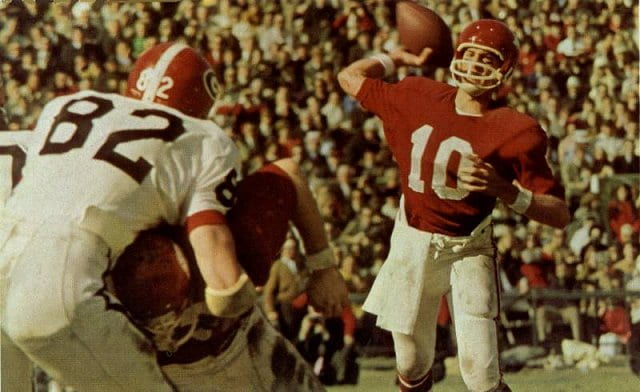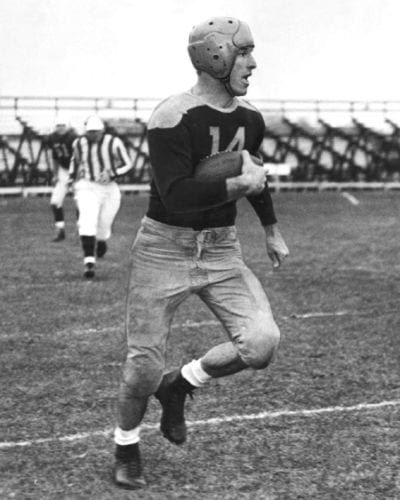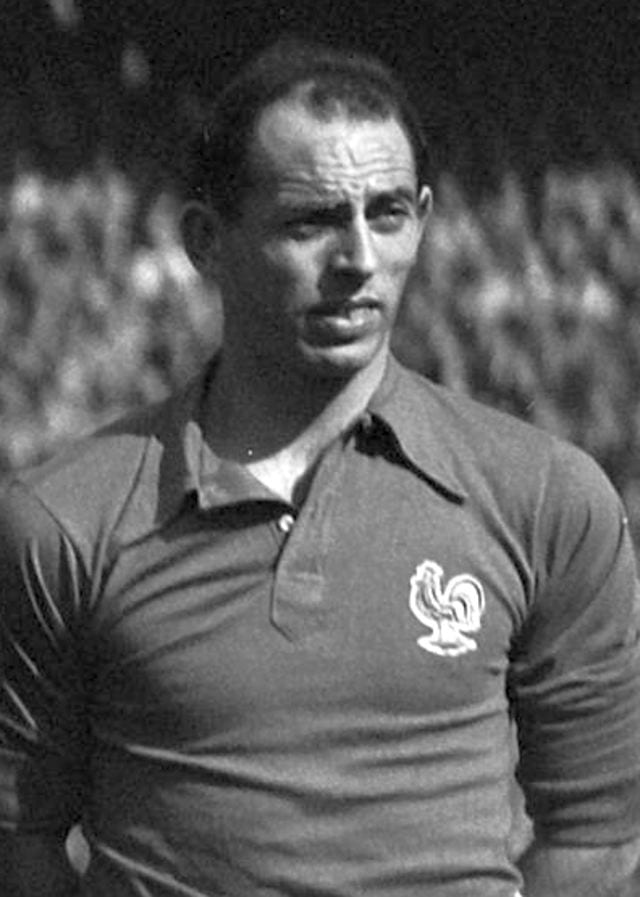by Laurent Bellaiche
The concept of multiverses implies the existence of parallel universes that all satisfy the same laws of Physics. This concept is rather controversial since it lacks evidence. Many scientists are against it, including the 2004 Nobel Laureate in Physics, David Gross, with the University of California at Santa Barbara. However, some respectable physicists do believe in the possibility of this concept including Brian Greene from Columbia University and the late Stephen Hawking from Cambridge, UK.
The intent of this article to use some uncanny resemblances between two specific universes in order to allow readers to have an open mind on the concept. Humor and irony are presently employed and my own beliefs on the provocative idea of parallel universes (if any) are not revealed here.
The First Universe
The first universe is the one of American football. More precisely, it is about our football team of the University of Arkansas. The following facts about it need to be emphasized.
The team’s nickname is the Razorbacks, which was chosen at the beginning of the 20th century, in 1909. It was voted by the student body after the coach of that time, Hugo Bezdek, marvelously declared after a 7-0 victory against Louisiana State University (LSU) that the team played like “a wild band of razorback Hogs’’ (note that the previous name of the football team of the University of Arkansas was the Arkansas Cardinals from 1894 to 1909).

Bill Montgomery playing for the Hogs against the university of Georgia in the 1969 Sugar Bowl, led by Frank Broyles
The most famous coach of the Razorbacks is likely Frank Broyles. He was born on December 26, 1924, in the Southeastern United States (in Decatur, Georgia). He played as the quarterback of Georgia Tech and brought that team to the Orange Bowl in 1945 against University of Tulsa Golden Hurricane (winner of that Bowl by 26 to 12). He then directed the Razorbacks for almost two decades between 1958 to 1976. With Broyles at the helm, Arkansas achieved its best successes, mostly in the fifties and sixties. The team became national champions in 1964 and won seven Southwest conference championships in 1959, 1960, 1961, 1964, 1965, 1968 and 1975. Broyles received the prestigious award of the AFCA Coach of the Year in 1964 and was also inducted into the College Football Hall of Fame in 1983. While still being the coach of the Hogs, he also dedicated himself to an even more important cause by becoming the Men’s Athletic Director for the University of Arkansas in 1974, a position that he kept until his retirement on December 31, 2007. Frank Broyles died in his beloved city of Fayetteville, AR, on August 14, 2017. His legacy is obviously evidenced by the fact that the field of the Donald W. Reynolds Razorback stadium bears his name and that its North end addition houses the Frank Broyles Athletic Center.
After Broyles’s tenure as coach, the Razorbacks experienced some downs but also some ups. In particular, for the latter, one can note the four SEC Western Division championships acquired or co-acquired in 1995, 1998, 2002 and 2006. An almost 10-year period in the nineties and 2000s therefore lifted the spirits of Arkansans.
Over the years, the Razorbacks saw some excellent players who went on to the NFL. Three Razorbacks have been inducted into the Football Hall of Fame: Lance Alworth who then played for the San Diego Chargers and Dallas Cowboys in the sixties and seventies; Dan Hampton, who won the Super Bowl with Chicago Bears in 1986 and for which he played from 1979 to 1990; and Steve Atwater, who spent 10 years with the Denver Broncos and then New York Jets from 1989 to 1999. None of these three players were born in Arkansas since Alworth is from Texas, Hampton from Oklahoma and Atwater from Illinois (though Dan Hampton graduated from Jacksonville high school in Arkansas).
One may also be led to believe that wearing the Hogs jersey can result in offspring who are gifted in sports, as evidenced by the fact that Alworth’s grandson, Brian Driscoll, is currently an offensive lineman at University of California, Berkeley.
Additionally, there is a least one highly successful NFL player born in Arkansas that never wore the Razorback jersey. His name was Donald Montgomery Hutson, who was also known as Don Hutson. He was born on January 31, 1913 in Pine Bluff, AR, where he also graduated from high school. Shockingly, Hutson joined one of Arkansas’s current rivals, the University of Alabama Crimson Tide, where he played from 1932 to 1934. That latter year, Alabama became national champions by being undefeated and is considered one of the best College football teams of all time. Hutson was then signed by the Green Bay Packers where he remained from 1935 to 1945 and where he won three NFL championship games in 1936, 1939 and 1944. He is typically considered as one of the best receivers in NFL history, and was chosen as NFL MVP in 1941 and 1942. The first number that Green Bay Packers retired was the number 14 in 1951, to honor Hutson. He died on June 26, 1997.
Talking about rivalries, the Razorbacks experience several of them with teams from neighboring states. In particular, two of these rivalries carry their own name: the battle for the Golden Boot with LSU because of the boot shape jointly formed by Arkansas and Louisiana; and the Battle Line Rivalry with the University of Missouri Tigers because of the state line between Arkansas and Missouri that divided the North and the South during the Civil war.
Finally, there are also two important facts associated with the Razorbacks. First of all, the official mascot is a male Russian boar named Tusk coming from a farm just outside Dardanelle, AR. The original Tusk was the mascot from 1997 to 2004, and the current one (Tusk VI) has done it since 2022. All the Tusks travel to every football game in Little Rock and Fayetteville (where they can even be seen inside the Stadium) as well as to big away events such as the Southwest Classic game or some bowl games. Secondly, Razorback fans are known to be passionate about our team, which is a big source of pride.
The Second Universe
The second universe is the one of … football, also known as soccer in a very few countries around the world, including the U.S. More precisely, it is about the French soccer team of Sedan, which takes the full name of Club Sportif Sedan Ardennes and which is often denoted as CS Sedan. The following facts about it need to be emphasized.
The team was created at the beginning of the 20th century, in 1919, and its nickname is Les Sangliers, which translates as the Wild Boars, because such animal is the symbol of the Ardennes department in France that the city of Sedan is a part of.
The most famous coach of Les Sangliers is likely Louis Dugauguez. He was born around the 1920s, on February 21, 1918, in the Southwestern part of France (in Thénac, Charente-Maritime). He played as a midfielder in several French clubs, including Lens, Toulouse and finally Sedan. He directed this latter team for more than two decades between 1948 to 1974. With Dugauguez at the helm, Sedan achieved its best successes in the fifties and sixties. The team won the French Cup twice, in 1956 and 1961. Technically, these two trophies were acquired under the name of UA Sedan-Torcy, (here, UA does not stand for the University of Arkansas but rather for Union Athlétique, with Torcy being a former city in the Ardennes department that is now an integral part of Sedan).
Unfortunately, the award of the best French coach of the year by the famous France Football magazine only started to be given out in 1970, which likely prevented Duguagez from receiving such a coveted trophy. While still being the coach of the Wild Boars, he also dedicated himself to an even more important cause by becoming the manager of the youth French National team in 1954 and then of the (Adult) French National team between 1967 to 1968. Unfortunately, his coaching career for Les Bleus (nickname of the French National team) was not so glorious, as evidenced by his record of two wins, three ties and four defeats in nine games. However, the sixties were the period when French soccer was at its lowest. Dugauguez died in his beloved city of Sedan on September 22, 1991. His legacy is evidenced by the fact that the stadium of CS Sedan bears his name.
After Dugauguez’s tenure as coach, Les Sangliers experienced some downs but also some ups. In particular, for the latter, Sedan went from the third to the second division in Summer 1998, and even came back to the first division in Summer 1999 after a 25-year gap. During the 1998-1999 season and while still being in second division, Sedan also played the finale of the French Cup, where they were defeated by Nantes by the small margin of 1-0. CS Sedan also finished fifth of the top-flight French division during the 2000-2001 season, after having thrashed 5-1 the giant Paris-Saint-Germain at Louis Dugauguez stadium. This fifth spot earned them the right to play in the 2001-2002 UEFA European Cup. Les Sangliers were, however, relegated to the French second division at the end of the 2002-2003 but came back to first division in Summer 2006. During the 2004-2005 season, they again managed the feat to play the Final of the French Cup while not being in the top-flight; finale that was narrowly lost to Auxerre by 2-1. An almost 10-year period in the nineties and 2000’s therefore lifted the spirits of les Sedanais (inhabitants of Sedan).
Over the years, the Sedan team saw some excellent players who also started to play for their home countries. Three of such Sangliers are: Pierre Bernard, a goalkeeper who won the 1961 French Cup with CS Sedan, was awarded the best French player prize in that 1961 year, and played 21 times for France between 1960 and 1965 – including four times as the captain; the defender Roger Lemerre, who wore the French jersey eight times between 1968 and 1971, before becoming a coach who made France European champion in 2000 and Tunisia the winners of the African Cup of Nations in 2004; and Pius N’Diefi, a striker who represented Cameroon 34 times on the international stage between 2000 and 2005, with whom he triumphed in the 2000 and 2002 African Cup of Nations.
One may also be led to believe that wearing Les Sangliers jersey can result in offspring who are gifted in sports, as evidenced by the fact that another winner of the 1961 French Cup with CS Sedan, the Cameroonian Zacharie Noah, has Yannick Noah as son and Joakim Noah as grandson. Yannick Noah, who is born in Sedan, is without any doubt one of the best tennis players that France ever produced. He won the 1983 French Open and was ranked third in singles and number one in doubles in the world in 1986. His son, Joakim Noah, was a two-time NCAA champion in 2006 and 2007 with the University of Florida, before having a 13-year career in NBA where he played for Chicago Bulls, New York Knicks, Memphis Grizzlies and Los Angeles Clippers.
There is a least one player who was born in the Ardennes department who shocklingly never wore the Sedan jersey during a highly successful career in the French top division. His name was Roger Marche, who was also known by his nickname, Le Sanglier des Ardennes (the Boar of the Ardennes). He was born on March 25, 1924 in Villers-Semeuse and went to play for the youth team of Charleville (also located in the Ardennes) when he was less than 20 years old. Shockingly, Marche then joined one of the rivals of Sedan, the Stade de Reims, where he played from 1944 to 1954. The team was located in the neighboring department of Marne, he won two French championships in 1949 and 1953, one French cup in 1950 and the European Latin Cup in 1953 (which is the ancestor of the UEFA European Cup). Marche was then signed by Racing Club Paris where he stayed from 1954 to 1962. This left back defender is one of the players with the highest number of appearances in the French top division, with 542 games. He was also part of the National French team for 12 years between 1947 and 1959, with which he played two world cups. The first one was in 1954, where France was eliminated during the group stage. The second and final one was in 1958, where France reached the semi-finals for the first time ever and then finished third. Roger Marche played 63 times for France in total, the national record at that time and that remained unbeaten until Marius Trésor broke it 24 years later. Interestingly, Marche only scored a single goal (due to his defensive position) with France, and this happened during his last game against the Spain of the legends Di Stefano (Golden Ball in 1957 and 1959), Luis Suarez (Golden Ball in 1960) and Paco Gento (the only player to have won six UEFA European Cups) in December 1959. His goal resulted in France winning by 4-3 and constituted another record at that time: the goal realized by the oldest French player, since Roger Marche was 35 years and 287 days. This record lasted about 63 years, when Olivier Giroud had a tally against Austria in September 2022. Roger Marche died the same year than Don Hutson, in 1997. It happened on November 1 (the day the dead persons are celebrated in France) in Charlevilles-Mezières, in his beloved department of les Ardennes.
Talking about rivalries, Les Sangliers experience several with teams from neighboring departments. In particular, two of these rivalries carry their own name: the Derby de Champagne-Ardenne with Reims because this latter city belongs to the Champagne area while Sedan is from the Ardennes, with the Chanpagne-Ardenne region having, of course, the shape of a boot that is very similar to that formed by Arkansas and Louisiana; and the Derby des Ardennes with Troyes. Interestingly, in 1956, the finale of the French cup for adults as well as that for under-18 opposed the arch-rivals of Sedan and Troyes. Les Sangliers came out victorious in both cases.
Finally, there are also two important facts associated with CS Sedan’s mascot. First of all, the official mascot is a wild boar, but can have different names and sexes. For instance, just before the 1956 French cup win, it was the male named Dudule who was presented to the public while it was the female Dora who was shown to the fans at the 1961 French Cup finale. Furthermore, Césarine was the female hog that had the honor to watch the 1999 and 2005 French finale cups. Secondly, the Sedan fans are known to be fully passionate about their team, that is a big source of pride.
During this article, we have seen many striking similarities between The Razorbacks and Les Sangliers, which, of course, call for the existence of parallel universes having similar laws of Physics. However, you have also noticed some differences between these two teams. For instance, Frank Broyles was from the Southeast of the U.S. and met success as the Men’s Athletic Director for the University of Arkansas, while Louis Dugauguez was from the Southwest of France and had a negative record with the national French team as its coach. Such differences rather hint that parallel universes can adopt opposite laws. Such latter point is further emphasized by a dramatic contrast between the soccer club of Sedan and the football team of Arkansas: about 20 or 30 years ago, several fans of CS Sedan sold their mopeds to buy season tickets and thus to financially contribute to their precious team. And, unless we overlooked something, we have never heard of any stories involving Mopeds and Razorback players or even coaches. Isn’t it right, y’all…
Laurent Bellaiche is a Distinguished Professor in the Physics Department and Institute for Nanoscience and Engineering, as well as the Twenty-First Century Endowed Professor in Optics, Nanoscience and Science Education (for more details, please see: ccmp.uark.edu). His favorite team is Paris Saint-Germain, especially that of the first trophies (French Cups) in the 1980’s, with the three Dominique’s (Baratelli, Bathenay and Rocheteau) and two jewels (Safet Susic and Mustapha Dahleb). His two favorite male football players of all time are Diego Armando Maradona and Robby Rensenbrink. His current three favorite female players are Grace Geyoro, Melchie Dumornay and, of course, Sophia Smith. His favorite soccer/football quote is one from Bill Shankly, “Some people think football is a matter of life and death – I assure you, it’s much more important than that.”




